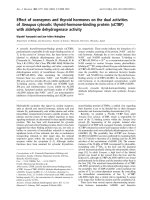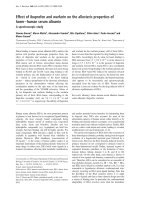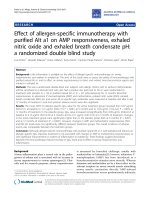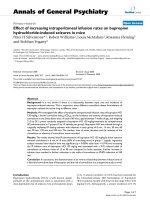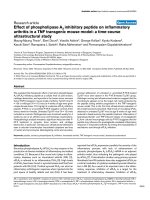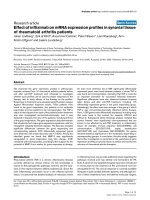Báo cáo y học: "Effect of increasing intraperitoneal infusion rates on bupropion hydrochloride-induced seizures in mice" pptx
Bạn đang xem bản rút gọn của tài liệu. Xem và tải ngay bản đầy đủ của tài liệu tại đây (222.93 KB, 7 trang )
BioMed Central
Page 1 of 7
(page number not for citation purposes)
Annals of General Psychiatry
Open Access
Primary research
Effect of increasing intraperitoneal infusion rates on bupropion
hydrochloride-induced seizures in mice
Peter H Silverstone*
1
, Robert Williams
2
, Louis McMahon
2
, Rosanna Fleming
3
and Siobhan Fogarty
2
Address:
1
Biovail Corporation, Mississauga, Ontario, Canada,
2
Biovail Technologies, Ltd, Dublin, Ireland and
3
Statistical Department, Biovail
Technologies, Ltd, Bridgewater, New Jersey, USA
Email: Peter H Silverstone* - ; Robert Williams - ;
Louis McMahon - ; Rosanna Fleming - ; Siobhan Fogarty -
* Corresponding author
Abstract
Background: It is not known if there is a relationship between input rate and incidence of
bupropion-induced seizures. This is important, since different controlled release formulations of
bupropion release the active drug at different rates.
Methods: We investigated the effect of varying the intraperitoneal infusion rates of bupropion HCl
120 mg/kg, a known convulsive dose
50
(CD
50
), on the incidence and severity of bupropion-induced
convulsions in the Swiss albino mice. A total of 69 mice, approximately 7 weeks of age, and weighing
21.0 to 29.1 g were randomly assigned to bupropion HCl 120 mg/kg treatment by intraperitoneal
(IP) administration in 7 groups (9 to 10 animals per group). Bupropion HCl was infused through a
surgically implanted IP dosing catheter with infusions in each group of 0 min, 15 min, 30 min, 60
min, 90 min, 120 min, and 240 min. The number, time of onset, duration and the intensity of the
convulsions or absence of convulsions were recorded.
Results: The results showed that IP administration of bupropion HCl 120 mg/kg by bolus injection
induced convulsions in 6 out of 10 mice (60% of convulsing mice) in group 1. Logistic regression
analysis revealed that infusion time was significant (p = 0.0004; odds ratio = 0.974) and increasing
the IP infusion time of bupropion HCl 120 mg/kg was associated with a 91% reduced odds of
convulsions at infusion times of 15 to 90 min compared to bolus injection. Further increase in
infusion time resulted in further reduction in the odds of convulsions to 99.8% reduction at 240
min.
Conclusion: In conclusion, the demonstration of an inverse relationship between infusion time of
a fixed and convulsive dose of bupropion and the risk of convulsions in a prospective study is novel.
Introduction
Bupropion hydrochloride (HCl), a well known antide-
pressant of the aminoketone class, is associated with a
dose-dependent risk of seizures even at therapeutic doses
[1-5]. A seizure incidence of 0.4% has been reported for
the immediate-release (IR) formulation of bupropion
HCl in patients treated with doses in the range 300 to 450
mg/day [3,5]. Subsequently, a seizure incidence of 0.1%
Published: 23 December 2008
Annals of General Psychiatry 2008, 7:27 doi:10.1186/1744-859X-7-27
Received: 16 July 2008
Accepted: 23 December 2008
This article is available from: />© 2008 Silverstone et al; licensee BioMed Central Ltd.
This is an Open Access article distributed under the terms of the Creative Commons Attribution License ( />),
which permits unrestricted use, distribution, and reproduction in any medium, provided the original work is properly cited.
Annals of General Psychiatry 2008, 7:27 />Page 2 of 7
(page number not for citation purposes)
was reported for the sustained-release (SR) formulation of
bupropion HCl in patients treated with doses of 100 to
300 mg/day [4,6]. In addition, a comparative study of
chronic dosing with Wellbutrin SR tablets 150 mg twice
daily vs Wellbutrin IR tablets 100 mg three times daily
revealed that both formulations were bioequivalent with
respect to the rate and extent of absorption but the peak
plasma concentrations of bupropion (C
max
) at steady state
for the SR tablets were 15% less and T
max
, the time to peak
plasma concentrations of bupropion was prolonged than
those obtained for the IR formulation [6]. It is not pre-
cisely known whether the lower 0.1% seizure incidence
observed for the SR formulation of bupropion is due to
the latter differences in the same dose of the formulations
or the lower dose administered in the SR prospective
safety surveillance study [4]. Furthermore, the relation-
ship of different rates of input of bupropion, with the
dose kept constant, to the incidence of bupropion-
induced seizures remains unknown. Therefore, the objec-
tive of this study was to investigate the effect of varying
infusion rates of bupropion HCl 120 mg/kg administered
intraperitoneally, a dose that has been previously shown
to be the convulsive dose
50
(CD
50
), the dose that will
induce convulsions in 50% of mice [7], on the incidence
and severity of bupropion-induced convulsions in Swiss
albino mice.
Materials and methods
The study protocol and any amendment(s) or procedures
involving the care and use of animals were reviewed and
approved by Charles River Laboratories Preclinical Serv-
ices Inc.'s (CRM) Institutional Animal Care and Use Com-
mittee. During the study, the animals were maintained in
a facility fully accredited by the Standards Council of Can-
ada (SCC) and the care and use of the animals was con-
ducted in accordance with the guidelines of the Canadian
Council on Animal Care (CCAC).
Animals
A total of 69 female Swiss Crl: CD1 (ICR) albino mice
(Mus Musculus; Charles River Canada Inc., St Constant,
Quebec, Canada) of approximately 7 weeks of age, and
weighing 21.0 to 29.1 g were housed individually in stain-
less steel wire mesh-bottomed cages equipped with an
automatic watering valve in an environmentally control-
led vivarium (temperature 22 ± 3°C; relative humidity 50
± 20%) with a 12-h light/dark cycle. Each animal was
uniquely identified using an indelible marker and each
cage was clearly labelled with a colour-coded cage card
indicating group, animal number and sex. All animals
were acclimated to their cages and to the light/dark cycle
for a period of 7 days prior to surgery and for at least 1
additional day post surgery prior to dosing. In addition,
all animals had free access ad libitum to a standard certi-
fied pelleted commercial laboratory diet (PMI Certified
Rodent Diet 5002; PMI Nutrition International Inc., St
Louis, MO, USA) and tap water except during designated
procedures. Prior to surgery and the initiation of treat-
ment, animals were randomly assigned to 7 treatment
groups of 10 mice per group, using a computer-based ran-
domisation procedure that ensures stratification by body
weights as follows: group 1, bupropion HCl 120 mg/kg by
bolus intraperitoneal (IP) injection; group 2, bupropion
HCl 120 mg/kg by IP infusion over 15 min; group 3,
bupropion HCl 120 mg/kg by IP infusion over 30 min;
group 4, bupropion HCl 120 mg/kg by IP infusion over
60 min; group 5, bupropion HCl 120 mg/kg by IP infu-
sion over 90 min; group 6, bupropion HCl 120 mg/kg by
IP infusion over 120 min; and group 7, bupropion HCl
120 mg/kg by IP infusion over 240 min. Animals could be
replaced after surgery but prior to the initiation of ran-
domised treatment, due to complications of surgery, ill-
ness or death. Additionally, animals in poor health or at
the extremes of the prespecified body weight range (18 to
30 g) were not assigned to treatment groups and unas-
signed animals were released from the study.
Surgical procedure
Animals assigned to groups 2 to 7 underwent surgery for
implantation of an intraperitoneal dosing catheter. Each
animal was prepared for surgery by shaving its ventral sur-
face, from the pubis to the thorax, and the interscapular
region. The shaved areas of skin were cleaned and disin-
fected with chlorhexidine gluconate 4% solution, fol-
lowed by sterile water and then povidone iodine 10%
solution. The animals then received a subcutaneous injec-
tion of an analgesic/anti-inflammatory agent, caprofen 5
mg/kg, and were anaesthetised using isoflurane anaesthe-
sia during the entire surgical procedure. A bland ophthal-
mic agent was administered to each eye prior to surgery
and was repeated during the procedure as deemed neces-
sary. An approximately 1 cm length of the end of a sili-
cone catheter (internal diameter 0.020 inches, outside
diameter 0.037 inches; Medique Products, St Louis, MO,
USA) was placed in the peritoneal cavity through a small
abdominal skin incision followed by another small inci-
sion into the abdomen through the linea alba. The cathe-
ter tip was positioned within the abdomen, the catheter
secured in place, and the surgical wound closed using
non-absorbable suture material. The other end of the
catheter was routed subcutaneously through an incision
in the interscapular region. Following surgery, the animals
were placed in a recovery box with a heat lamp for a few
minutes to facilitate recovery, after which they were
returned to their home cage, equipped with a flat metal
bottom and nesting material.
Drugs
Bupropion HCl was obtained from Biovail Corporation,
Steinbach, Manitoba, Canada, in white powder form,
Annals of General Psychiatry 2008, 7:27 />Page 3 of 7
(page number not for citation purposes)
with 100.3% purity, lot number RM0400 and expiry date
of October 2007. Vehicle was 0.9% sodium chloride
(NaCl) for injection USP and was obtained from Baxter
Healthcare Corporation (Deerfield, IL, USA) in clear liq-
uid form, with lot number W6J12C2, and expiry date of
January 2008.
The dose formulations of bupropion HCl were prepared
on each day. The appropriate amount of bupropion HCl
was weighed and dissolved in an appropriate amount of
0.9% NaCl in a suitable container and then vortexed until
complete dissolution of the material. On each day of treat-
ment, bupropion HCl 120 mg/kg was administered by IP
injection in a dose volume of 10 ml/kg and dose concen-
tration of 12 mg/ml as a bolus (for group 1) or intraperi-
toneally infused at a dose rate of 40, 20, 10, 6.67, 5 and
2.5 ml/kg/h for groups 2, 3, 4, 5, 6, and 7, respectively.
The actual dose administered was based on the most
recent body weight of each animal. The dose formulations
were kept at room temperature and protected from light.
Study procedure
All animals were examined twice daily for mortality and
signs of ill health or reaction to treatment, except on the
days of arrival and necropsy when they were examined
only once. After the acclimation period and randomisa-
tion, on the day prior to the initiation of treatment, all
animals were weighed and the individual body weights
were used for dose volume calculation. Treatment was
then initiated and lasted for 3 consecutive days with equal
numbers of animals from each group dosed on each day.
During treatment, all animals were observed continu-
ously for the occurrence of convulsions and for a period
of 2 h post completion of infusion of treatment. A 5-min
observation period was also conducted at 24 h post dose.
Animals were placed in clear Perspex observation boxes
during the observation periods. During the observation
periods, the number, time of onset, duration and the
intensity of the convulsions were recorded. The intensity
of each convulsion was graded using Charles River Labo-
ratories, Inc.'s grading system of mild: head and tail
slightly extended and little jerking; moderate: head and
tail fully extended and some jerking; or severe: head and
tail fully extended and strong jerking. In addition, the
presence or absence of ataxic gait, paralysis, and catatonic
episodes (without a grading of the intensity or number)
were recorded over each 15 min observation period. Any
animal that had a single episode of severe seizure lasting
longer than 1 min or any animal displaying greater than
40 separate episodes of severe convulsions over a 1-h
period was killed for humane reasons. At the end of the
study, all animals were killed using humane methods.
Assessment of convulsant activity
The primary outcome variable was the percentage (%) of
convulsing mice following treatment. This was the
number of animals with convulsions divided by the total
number of animals in each group multiplied by 100. The
secondary outcome variables were the time to onset of
convulsions, mean ± SD convulsions per mouse in each
group, the duration of convulsions, and the intensity of
convulsions.
Statistical analysis
Data was summarised and presented in tables by treat-
ment groups for the primary outcome variable, the per-
centage of convulsing mice, and the four secondary
outcome variables, the time to onset of convulsions,
mean ± SD convulsions per mouse in each group, dura-
tion of convulsions, and intensity of convulsions. For the
primary outcome variable, because convulsion, the
dependent variable, is a binary outcome, the relationship
between the probability of having a convulsion and the
infusion rate was analysed using a logistic regression
model. The actual infusion times from the seven treat-
ment groups were used as the predictor variable in the
logistic regression model. Time to onset of convulsions
was analysed using the Cox proportional hazards model
to compare each treatment group (groups 2 to 7) and the
bolus injection treatment group (group 1). The precise
time to onset of convulsions was not recorded for mouse
6 in group 2 due to technical difficulties. Imputation for
this missing value was by the mid point of the (known)
15-min observation interval when convulsions started. All
mice that did not have convulsions during treatment infu-
sion and by the end of the 2-h post-treatment observation
period were considered to be censored at 120 min. A p
value of ≤ 0.05 was considered statistically significant.
Results
In each group 10 animals were dosed, except group 5
where only 9 animals were dosed due to logistical reasons.
Following bolus IP injection of bupropion HCl 120 mg/
kg to animals in group 1 and intraperitoneal infusion of
the same dose of bupropion HCl to animals in groups 3
to 7, no deaths occurred. However, in group 2 (15 min
infusion time), two animals were killed in extremis for
humane reasons within 15 and 75 min of dosing, respec-
tively.
Following administration of treatment, a variety of clini-
cal signs was observed in mice across all treatment groups
including ataxic gait, catatonia, decreased activity and/or
paralysis. The number of animals with the observed clini-
cal signs varied inversely with the infusion time, with the
animals administered IP bupropion HCl 120 mg/kg by
bolus injection showing the most number of clinical
Annals of General Psychiatry 2008, 7:27 />Page 4 of 7
(page number not for citation purposes)
signs. Paralysis and/or lying on the side were observed in
8 out of 10 mice in group 1.
Percentage of convulsing mice
The IP administration of bupropion HCl 120 mg/kg by
bolus injection induced convulsions in 6 out of 10 mice
(60% of convulsing mice) in group 1. Increasing the total
time of IP infusion of bupropion HCl to 15 min (group 2)
while maintaining the dose constant (120 mg/kg) was
associated with an increase in the percentage of convuls-
ing mice to 90%. Subsequent increases in the IP infusion
time of bupropion HCl 120 mg/kg to 30, 60, 90, 120 and
240 min were associated, in general, with a corresponding
decrease in the percentage of convulsing mice to 50%,
50%, 0%, 20% and 0%, respectively, for mice in groups 3
to 7 (Table 1).
Logistic regression analysis of treatment infusion time vs
the probability of having a convulsion showed that infu-
sion time was statistically significant (p = 0.0004) with an
estimated odds ratio of 0.974, indicating that when infu-
sion time increases by 1 min, the odds (or probability) for
a mouse having a convulsion vs not having a convulsion
decreases by 2.6%. Using the estimated odds ratio, the
decreases in the probability for a mouse having a convul-
sion were calculated for the infusion times used in groups
2 to 7 (Table 1). The results show that as infusion time
increases, with dose kept constant, mice are at progres-
sively reduced odds of having convulsions, with the odds
markedly reduced by 55% with the infusion time of 30
min, by 91% with infusion time of 90 min, and almost
zero at 240 min. These results also confirm that the initial
increase in the percentage of convulsing mice observed at
the IP infusion time of 15 min is random.
Time to onset of convulsions
The time to onset of convulsions for the individual mouse
in each group are shown in Table 2. The observed shortest
times to onset of first convulsions were 5, 6 and 7 min in
group 1, the bolus injection group, while the observed
longest times to onset of first convulsions were 70, 69 and
60 min in group 4, the 60 min infusion time group.
Between groups 1 and 4, there was a progressive increase
in the time to onset of first convulsions with increase in
infusion time. The results of the Cox proportional hazards
model showed that infusion time was statistically signifi-
cant (p = 0.0002) with a hazard ratio of 0.978, indicating
a 2.2% reduction in the hazard (probability) of a mouse
having a convulsion when the infusion rate increases by 1
min. This hazard ratio is consistent with the odds ratio
obtained by logistic regression analysis above.
Mean ± SD convulsions per mouse
The IP administration of bupropion HCl 120 mg/kg by
bolus injection (group 1) induced a total of 155 episodes
of convulsions or 15.5 ± 22.4 mean ± SD convulsions per
mouse. Increasing the IP infusion time for the same dose
of bupropion HCl to 15 min (group 2) resulted in an
increase in the total number of convulsions to 272 con-
vulsions or 27.2 ± 39.5 mean ± SD convulsions per mouse
(Table 3). The odds ratio and the hazard ratio results indi-
cate that this increase is random. Further increase in IP
infusion times to 30 and 60 min (groups 3 and 4) resulted
in 161 or 16.1 ± 22.2 and 170 or 17.0 ± 22.8 total or mean
± SD convulsions per mouse, respectively, which were
similar to the results obtained for the bolus injection
(group 1). Additional increase in IP infusion times for the
same dose of bupropion HCl to 90, 120 and 240 min,
resulted in either no convulsions or a minimal number of
total or mean convulsions per mouse (Table 3). Overall,
IP infusion times of 0 to 60 min generally resulted in a sta-
ble number of mean convulsions per mouse, while
increases in infusion time to ≥ 90 min resulted in either
no convulsions or a minimal number of mean convul-
sions per mouse.
Duration and intensity of convulsions
The mean numbers of short, medium and long duration
convulsions were generally stable for infusion times of 0
to 60 min (Tables 4 and 5). Infusion times of ≥ 90 min
Table 1: Effect of bupropion HCl 120 mg/kg intraperitoneal infusion times on bupropion HCl-induced percentage of convulsing mice
and on odds of convulsing vs not convulsing
Group* Intraperitoneal (IP) infusion time (min) No. of mice convulsing Convulsing mice Reduction in odds of convulsing†
10 (bolus) 660% -
215 990%32.6%
330 550%54.6%
460 550%79.4%
5 90 0 0% 90.6%
6 120 2 20% 95.8%
7240 00%99.8%
*Number of mice was 10 for each group, except group 5 that had 9 mice.
†Reduced odds of convulsing vs not convulsing for any infusion time, x min, were calculated using the formula: 1 - (0.974
x
) × 100%; where 0.974
was the odds ratio estimate obtained from logistic regression analysis, and x = infusion time (min).
Annals of General Psychiatry 2008, 7:27 />Page 5 of 7
(page number not for citation purposes)
resulted in either no convulsions or a minimal number of
short, medium and long convulsions. Within the groups
that had convulsing mice, for each IP infusion time, the
mean ± SD numbers of short duration convulsions were
highest followed by the medium and then the long con-
vulsions. Overall, the trend of the results obtained for the
intensity of convulsions was similar to that observed for
the duration of convulsions except in group 1 where there
were no severe convulsions (Tables 4 and 5).
Discussion
When used as an antidepressant, to minimise the risk of
seizures, the labels for the various formulations of bupro-
pion HCl recommend: (i) that the total daily dose of Well-
butrin and Wellbutrin XL not exceed 450 mg/day, and
Wellbutrin SR not exceed 400 mg/day; (ii) a maximum
single dose and minimum time interval between single
doses to avoid high peak concentrations of bupropion
and/or its metabolites; and (iii) the rate of incrementation
of dose be gradual [5,6,8]. It is also recommended that
significant caution be exercised when administering
bupropion HCl to patients with predisposing factors that
may increase the risk of seizures, which include patient
factors and the use of concomitant medications. However,
these recommendations are based strictly on retrospective
analysis of clinical experience gained during the develop-
ment of bupropion [5,6,8]. There are no published studies
of the effect of different rates of administration of a fixed
and convulsive dose of bupropion HCl on the incidence
and severity of bupropion HCl-induced seizures in ani-
mals or humans. Hence, this study was designed to inves-
tigate the effect of different infusion rates of a fixed,
convulsive dose of bupropion HCl, previously shown to
be a CD
50
, in Swiss albino mice [7].
The results of this study show that IP administration of
bupropion HCl 120 mg/kg by bolus injection induced
convulsions in 60% of mice and increasing the IP infusion
time of this fixed dose was initially associated with an
increase in the percentage of convulsing mice at 15 min
infusion time followed generally by a decrease to 0% of
convulsing mice at 90 min. Logistic regression analysis
showed that infusion time was statistically significant and
that the strength of the latter association (odds ratio) was
less than 1, confirming that the odds of having convul-
sions decreased with increase in infusion time. The odds
ratio also confirmed that the increase in the percentage of
convulsing mice at the 15 min infusion time was a ran-
dom occurrence. Furthermore, using the odds ratio to cal-
culate the reduction in the odds of convulsions for each
Table 2: Effect of bupropion HCl 120 mg/kg intraperitoneal infusion times on time to onset of bupropion HCl-induced convulsions and
on odds of convulsing vs not convulsing in mice
Group* Intraperitoneal (IP) infusion
time (min)
Time to Onset of Convulsions for Individual
Mice (min)†
Reduction in hazard (probability) of
convulsing
1 0 (bolus) 7; 30; 6; 120; 5; 11; 120; 120; 23; 120 -
2 15 15; 120; 5; 18; 19; 23; 14; 20; 16; 13 28.4%
3 30 20; 120; 17; 120; 120; 120; 120; 39; 42; 31 48.7%
4 60 32; 120; 42; 120; 120; 60; 120; 70; 120; 69 73.7%
5 90 120; 120; 120; 120; 120; 120; 120; 120; 120 86.5%
6 120 120; 9; 41; 120; 120; 120; 120; 120; 120; 120 93.1%
7 240 120; 120; 120; 120; 120; 120; 120; 120; 120; 120 99.5%
*Number of mice was 10 for each group, except group 5 that had 9 mice.
†Mice that did not have convulsions during treatment infusion and by the end of the 2-h post-treatment period were considered to be censored at
120 min.
‡Reduced hazard of convulsing vs not convulsing for any infusion time, x min, was calculated using the formula: 1 - (0.978
x
) × 100%; where 0.978
was the hazard ratio estimate obtained from Cox proportional hazards model, and x = infusion time (min).
Table 3: Effect of bupropion HCl 120 mg/kg intraperitoneal infusion times on the mean ± SD bupropion HCl-induced convulsions per
mouse
Group* Intraperitoneal (IP) infusion time (min) Total no. of convulsions Mean ± SD convulsions per mouse
1 0 (bolus) 155 15.5 ± 22.4
2 15 272 27.2 ± 39.5
3 30 161 16.1 ± 22.2
4 60 170 17.0 ± 22.8
590 0 0
6 120 34 3.4 ± 10.4
7240 0 0
*Number of mice was 10 for each group, except group 5 that had 9 mice.
Annals of General Psychiatry 2008, 7:27 />Page 6 of 7
(page number not for citation purposes)
infusion time used in the study (15, 30, 60, 90, 120 and
240 min) revealed there was a marked reduction (91%) in
the risk of convulsions during the first 90 min of infusion
time, after which the risk of convulsions continued to
decrease to an almost complete reduction (99.8%) at 240
min. The magnitude of the hazard ratio, an estimate of the
relative risk, obtained from the Cox proportional hazards
model used to analyse the time to onset of convulsions
was consistent with the odds ratio, indicating the robust-
ness of the relationship between increasing infusion time
and reduction in the risk of convulsions.
A consistent trend was observed in the results of the other
secondary outcome variables, the mean convulsions per
mouse, duration of convulsions, and intensity of convul-
sions. Overall, infusion times of 15 to 60 min (groups 2
to 4) were associated with stable mean convulsions per
mouse, a stable number of mean short, medium and long
convulsions, as well as a stable number of mild, moderate
and severe convulsions compared to the bolus injection
group (group 1); however, there were no severe convul-
sions in group 1. Infusion times of ≥ 90 min resulted in
either no convulsions (at 90 and 240 min) or a minimal
number of convulsions. In addition, the number of ani-
mals observed with clinical signs following treatment was
higher in mice in the bolus injection group and then
decreased with increase in infusion time. The reason why
the results of these secondary outcome variables were sta-
ble for infusion times of 0 to 60 min while there was a
marked and progressive reduction in the odds of convul-
sions during the same infusion time range is not known.
Additionally, the precise aetiology of bupropion-induced
seizures is unknown, and it is not known whether the risk
is due principally to the parent drug or to one of its three
major metabolites or a combination of more than one of
the four [2,9,10]. However, it is well established that
bupropion HCl-induced convulsions are dose dependent,
and hence, concentration dependent [1-6,9]. The C
max
of
a drug is determined by the dose, rate of input and elimi-
nation rate. Since the dose was kept constant in this study,
and assuming that the elimination rate was constant as
well during the study, the C
max
of bupropion would be
determined by the rate of input of bupropion HCl. There-
fore, it may be hypothesised that for infusion times of
between 0 to 60 min, there was a progressive reduction in
the risk of convulsions and hence, the observed number
of mice with convulsions. However, in those mice that
had convulsions, the concentrations of blood bupropion
and/or the metabolites were high enough to induce con-
vulsions of the same frequency (mean convulsions per
Table 4: Effect of bupropion HCl 120 mg/kg intraperitoneal infusion times on the mean ± SD duration of bupropion HCl-induced
convulsions in mice
Group* Intraperitoneal (IP) infusion time (min) Mean ± SD duration of convulsions
Short
(0 to 10 s)
Medium
(11 to 30 s)
Long
(= 31 s)
1 0 (bolus) 11.2 ± 15.6 2.6 ± 3.9 1.6 ± 4.4
2 15 19.9 ± 31.4 4.8 ± 8.0 2.3 ± 3.3
3 30 12.2 ± 15.7 2.5 ± 4.1 1.4 ± 4.1
4 60 12.0 ± 17.7 3.8 ± 7.1 1.0 ± 1.7
590 000
6 120 3.1 ± 9.5 0.2 ± 0.6 0.1 ± 0.3
7240 000
*Number of mice was 10 for each group, except group 5 that had 9 mice.
Table 5: Effect of bupropion HCl 120 mg/kg intraperitoneal infusion times on the mean ± SD intensity of bupropion HCl-induced
convulsions in mice
Group* Intraperitoneal (IP) infusion time (min) Mean ± SD intensity of convulsions
Mild Moderate Severe
1 0 (bolus) 10.0 ± 12.9 5.5 ± 10.4 0
2 15 14.2 ± 17.4 7.1 ± 10.9 5.9 ± 13.1
3 30 9.2 ± 11.7 4.1 ± 6.4 2.8 ± 8.9
4 60 10.2 ± 16.4 4.6 ± 7.0 2.2 ± 4.8
590 000
6 120 2.8 ± 8.5 0.5 ± 1.6 0.1 ± 0.3
7240 000
*Number of mice was 10 for each group, except group 5 that had 9 mice.
Annals of General Psychiatry 2008, 7:27 />Page 7 of 7
(page number not for citation purposes)
mouse), duration and intensity. At infusion times of ≥ 90
min, however, the combined effect of the reduction in the
risk of convulsions and the lower concentrations of blood
bupropion and/or the metabolites resulted in a minimal
number of convulsions or did not induce any convulsions
at all. The findings that the time to onset of convulsions
progressively increased and the number of animals with
observed clinical signs progressively decreased with
increase in infusion time from 0 to 60 min supports this
'threshold' hypothesis.
The IP route of bupropion HCl administration was used
in this study because it is considered to be a route that
involves the first-pass effect and, therefore, gains access to
the hepatic portal system, making it more similar to oral
administration [11]. The high dose of bupropion HCl
used in this study was to ensure that convulsions occurred
in the mice, and it is noteworthy that even higher doses
have been recorded in overdose experience in humans
previously. The label for Wellbutrin XL indicates that
overdoses of up to 17,500 mg (equals 250 mg/kg for 70
kg adult) of the immediate-release formulation have been
reported in humans since the introduction of bupropion
and seizure was reported only in one-third of all cases [8].
The time to onset of first convulsion of 5 min observed in
this study is consistent with previous reports of median
latency to first convulsions obtained in male Swiss albino
mice of 6 (3.5 to 8.15) and 6.71 (4.83 to 7.16) min fol-
lowing the IP administration of an anticonvulsant dose of
bupropion HCl 160 and 75 to 150 mg/kg [7,12], respec-
tively. The latter finding confirms the validity of this epi-
letogenic experimental model.
The bupropion HCl used in this study was the powder dis-
solved in saline, which is very similar to the immediate-
release formulation used clinically. The immediate-
release formulation of bupropion HCl has been previ-
ously reported to have a T
max
of 15.6, 23.4 and 15.6 min
for bupropion parent drug, hydroxybupropion (BW
306U) and threohydrobupropion (BW A494U), respec-
tively, following IP administration of bupropion HCl 40
mg/kg (Suckow et al.) [11].
In conclusion, we have demonstrated that increasing the
IP infusion time of a fixed dose of bupropion HCl 120
mg/kg, a CD
50
in mice, was associated with a 91% mark-
edly reduced odds of convulsions at infusion times of 15
to 90 min compared to bolus injection. Further increase
in infusion time resulted in further reduction in the odds
of convulsions to 99.8% reduction at 240 min. The hazard
ratio obtained from the analysis of time to onset of con-
vulsions using the Cox proportional hazards model was
consistent with the odds ratio, confirming the robustness
of the strength of the relationship between infusion time
and the risk of convulsions. In contrast, generally a similar
number of mean convulsions per mouse, duration and
intensity of convulsions were observed at infusion times
of 15 to 60 min compared to bolus injection. Infusion
times of ≥ 90 min resulted in either a minimal number of
convulsions or no convulsions at all. The demonstration
of an inverse relationship between infusion time of a fixed
and convulsive dose of bupropion and the risk of convul-
sions is novel.
Competing interests
The authors declare that they have no competing interests.
Authors' contributions
PHS participated in the design of the study and drafted the
manuscript. RW participated in the design of the study
and its coordination. LM participated in the design of the
study and its coordination. RF performed the statistical
analysis. SF participated in the design of the study and its
coordination. All authors read and approved the final
manuscript.
Acknowledgements
Funding for the conduct of this study and the manuscript preparation was
provided by Biovail Laboratories International SRL.
References
1. Peck AW, Stern WC, Watkinson C: Incidence of seizures during
treatment with tricyclic antidepressant drugs and bupro-
pion. J Clin Psychiatry 1983, 44:197-201.
2. Davidson J: Seizures and bupropion: a review. J Clin Psychiatry
1989, 50:256-261.
3. Johnston JA, Lineberry CG, Ascher JA, Davidson J, Khayrallah MA,
Feighner JP, Stark P: A 102-center prospective study of seizure
in association with bupropion. J Clin Psychiatry 1991, 52:450-456.
4. Dunner DL, Zisook S, Billow AA, Batey SR, Johnston JA, Ascher JA:
A prospective safety surveillance study for bupropion sus-
tained-release in the treatment of depression. J Clin Psychiatry
1998, 59:366-373.
5. GlaxoSmithKline: Wellbutrin® (bupropion hydrochloride) tablets product
monograph Brentford, UK: GSK; 2006.
6. GlaxoSmithKline: Wellbutrin SR® (bupropion hydrochloride) sustained-
release tablets product monograph Brentford, UK: GSK; 2006.
7. Tutka P, Barczynski B, Wielosz M: Convulsant and anticonvulsant
effects of bupropion in mice. Eur J Pharmacol 2004, 499:117-120.
8. GlaxoSmithKline: Wellbutrin XL™ (bupropion hydrochloride extended-
release tablets) product monograph Brentford, UK: GSK; 2003.
9. Preskorn SH: Should bupropion dosage be adjusted based
upon therapeutic drug monitoring? Psychopharmacol Bull 1991,
27:637-643.
10. Preskorn SH: Bupropion: what mechanism of action? J Pract Psy-
chiatry Behav Health 2000, Jan:272-276.
11. Suckow RF, Smith TM, Perumal AS, Cooper TB: Pharmacokinetics
of bupropion and metabolites in plasma and brain of rats,
mice, and guinea pigs. Drug Metab Dispos 1980, 14:692-697.
12. Tutka P, Mroz T, Klucha K, Piekarczyk M, Wielosz M: Bupropion-
induced seizures: preclinical evaluation of antiepileptic
drugs. Epilepsy Res 2005, 64:13-22.
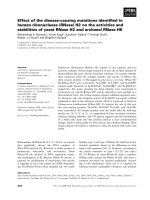
![Báo cáo Y học: Effect of adenosine 5¢-[b,c-imido]triphosphate on myosin head domain movements Saturation transfer EPR measurements without low-power phase setting ppt](https://media.store123doc.com/images/document/14/rc/vd/medium_vdd1395606111.jpg)
